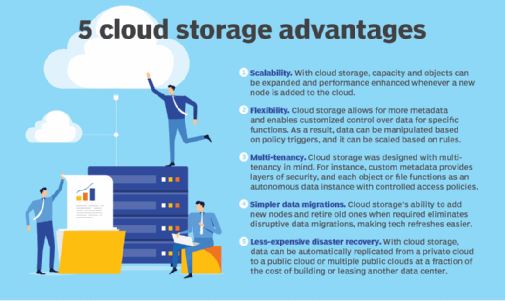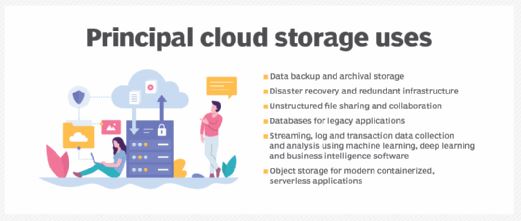What is Cloud Storage? Read Things You Need To Know
Cloud storage is primarily based totally on a virtualized storage infrastructure with on hand interfaces, near-on the spotaneous elasticity and scalability, multi-tenancy, and metered sources. Cloud-primarily based totally statistics is saved in logical swimming pools throughout disparate, commodity storage servers placed on premises or in a statistics middle controlled via way of means of a third-celebration cloud provider.
Cloud provider companies control and preserve statistics transferred to the cloud. Storage offerings are furnished on call for withinside the cloud, with capability growing and reducing as needed. Organizations opting for cloud storage remove the want to buy, control and preserve in-residence storage infrastructure. Cloud storage has greatly pushed down the per-gigabyte value of storage, however cloud storage companies have brought working costs which could make the era substantially greater expensive, relying on how it is used.
Types of cloud storage
There are 3 most important cloud storage options, primarily based totally on distinctive get entry to models: public, personal and hybrid.
Public cloud. These storage offerings offer a multi-tenant storage surroundings this is maximum acceptable for unstructured statistics on a subscription basis. Data is saved withinside the provider provider's statistics facilities with storage statistics unfold throughout more than one areas or continents. Customers commonly pay on a per-use basis, just like the application fee version. In many cases, there also are transaction prices primarily based totally on frequency and the extent of statistics being accessed. This marketplace quarter is ruled via way of means of the subsequent offerings:
- Amazon Simple Storage Service (S3);
- Amazon Glacier for deep archival or bloodless storage;
- Google Cloud Storage;
- Google Cloud Storage Nearline for bloodless statistics; and
- Microsoft Azure.
Private cloud. A personal cloud storage provider is an in-residence storage aid deployed as a devoted surroundings blanketed in the back of a firewall. Internally hosted personal cloud storage implementations emulate a number of the functions of industrial public cloud offerings, offering clean get entry to and allocation of storage sources for commercial enterprise customers, in addition to item storage protocols. Private clouds are suitable for customers who want customization and greater manage over their statistics or who've stringent statistics protection or regulatory requirements.
Hybrid cloud. This cloud storage choice is a mixture of personal cloud storage and third-celebration public cloud storage offerings, with a layer of orchestration control to operationally combine the 2 platforms.
The version gives companies flexibility and greater statistics deployment options. An business enterprise might, for example, save actively used and based statistics in an on-premises personal cloud and unstructured and archival statistics in a public cloud. A hybrid surroundings additionally makes it simpler to address seasonal or unanticipated spikes in statistics advent or get entry to via way of means of cloud bursting to the external storage provider and averting having to feature in-residence storage sources.
Adoption of the hybrid cloud version has accelerated in current years. Despite the advantages of hybrid clouds, they gift technical, commercial enterprise and control challenges. For example, personal workloads should get entry to and engage with public cloud storage companies, so compatibility, and dependable and sufficient community connectivity are essential factors. An employer-level cloud storage device must be scalable to fit present day and destiny desires, on hand from everywhere and software-agnostic.
How does cloud storage work?
Cloud provider companies preserve huge statistics facilities in more than one places across the world. When clients purchase cloud storage from a provider, they flip over maximum factors of the statistics storage to the vendor, consisting of protection, capability, storage servers and computing sources, statistics availability and shipping over a community. Customer programs can get entry to the saved cloud statistics via traditional storage protocols or software programming indicators (APIs), or they also can be moved to the cloud.
How cloud storage works varies relying on the sort of storage used. The 3 most important kinds are block storage, document storage and item storage:
- Block storage divides huge volumes of statistics into smaller gadgets referred to as blocks. Each block is related to a completely unique identifier and positioned on one of the device's storage drives. Block storage is speedy, green and presents the low latency required via way of means of programs inclusive of databases and high-overall performance workloads.
- File storage organizes statistics in a hierarchical device of documents and folders; it's far typically used with non-public computer storage drives and community-attached storage (NAS). Data in a document storage device is saved in documents, and the documents are saved in folders. Directories and subdirectories are used to arrange the folders and find documents and statistics. A document storage-primarily based totally cloud could make statistics get entry to and retrieval simpler, with this hierarchical layout being acquainted to customers and required via way of means of a few programs.
- Object storage shops statistics as objects, which include 3 components: statistics saved in a document, metadata related to the statistics document and a completely unique identifier. Using the RESTful API, an item storage protocol shops a document and its related metadata as a unmarried item and assigns it an identification (ID) range. To retrieve content material, the consumer affords the ID to the device and the content material is assembled with all its metadata, authentication and protection. Object-primarily based totally storage structures permit metadata to be customized, that may streamline statistics get entry to and analysis. With item storage, statistics may be saved in its local layout with huge scalability.
In current years, item storage companies have brought document device capabilities and skills to their item storage software program and hardware in large part due to the fact item storage became now no longer being followed speedy enough. For example, a cloud storage gateway can offer a document device emulation the front cease to its item storage; that association frequently lets in programs to get entry to the statistics with out assisting an item storage protocol. All backup programs use the item storage protocol, that's one of the motives why on line backup to a cloud provider became the preliminary a success software for cloud storage.
Most industrial cloud storage offerings use widespread numbers of tough drive storage structures set up in servers which are connected via way of means of a mesh-like community architecture. Service companies have additionally brought high-overall performance layers to their virtual storage offerings, generally made from solid-nation drives (SSDs). High-overall performance clouds storage is commonly simplest if the servers and programs gaining access to the storage also are resident withinside the cloud surroundings.
Learn greater approximately the professionals and cons of block, document and item storage.
Advantages and downsides of cloud storage
Cloud storage presents many advantages that bring about value financial savings and more comfort for customers, as compared with a traditional storage location networks (SAN). There are also shortcomings with cloud storage -- particularly, the general public offerings -- that make agencies hesitant to apply those offerings or restrict how they use them.
Advantages
- Pay as you go. With a cloud storage provider, clients best pay for the storage they use, doing away with the want for massive capital costs. While cloud storage expenses are habitual, in place of a one-time purchase, they're frequently so low that, while an ongoing expense, they'll nevertheless be much less than the value of preserving an in-residence device.
- Utility billing. Because clients best pay for the capability they use, cloud storage expenses can lower as utilization drops. This is in stark evaluation to the use of an in-residence storage device, that allows you to probable be over configured to address expected growth. A enterprise pays for greater than it desires initially, and the value of the storage will by no means lower.
- Global availability. Cloud storage is generally to be had from any device, everywhere and at any time; customers do now no longer should fear approximately working device (OS) functionality or complicated allocation processes.
- Ease of use. Cloud storage is straightforward to get entry to and use, so developers, software program testers and commercial enterprise customers can rise up and walking quick while not having to watch for an IT (statistics era) group to allocate and configure storage sources.
- Off-webweb page protection. By its very nature, public cloud storage gives a manner to transport copies of statistics to a faraway webweb page for backup and protection purposes. Again, this represents a big value financial savings whilst as compared to a enterprise preserving its very own faraway facility.
An in-residence cloud storage device can provide a number of the above ease-of-use functions of a public cloud provider, however it's going to lack a good deal of the storage capability flexibility of a public provider. Some hardware companies are seeking to deal with this trouble via way of means of permitting their clients to show on and rancid capability that has already been set up of their arrays.
Scalability, flexibility and multi-tenancy are all a number of the benefits of the use of cloud storage.
Disadvantages
- Security. Data protection is the maximum mentioned issue that can make groups careful approximately the use of public cloud storage. The challenge is that after statistics leaves a enterprise's premises, it not has manage over how the statistics is dealt with and saved. Storing regulated statistics is likewise a challenge. Service companies have attempted to allay the ones fears via way of means of improving their protection skills with statistics encryption, multifactor authentication (MFA), statistics storage in more than one places and advanced bodily protection.
- Data get entry to. Maintaining get entry to to statistics saved withinside the cloud also can be an trouble and will notably boom the value of the use of cloud storage. A enterprise can also additionally want to improve its connection to the cloud storage provider to address the extent of statistics it expects to transmit. For instance, the month-to-month value of an optical hyperlink can run into the hundreds of dollars.
- Performance degradation. A enterprise can also additionally run into overall performance problems if its in-residence programs want to get entry to the statistics it has saved withinside the cloud. In the ones cases, it's going to probable require both transferring the servers and programs into the same cloud or bringing the vital statistics returned in-residence.
- Cost. If a enterprise calls for plenty of cloud storage capability and often actions its statistics backward and forward among on-premises structures and the cloud, the month-to-month expenses may be high. Compared to deploying the storage in-residence, the continuing expenses ought to subsequently surpass the value of imposing and preserving the on-premises device.
Cloud storage considerations
To decide whether or not the use of cloud storage will bring about operational efficiencies and be value-powerful, a enterprise should take those 4 steps:
- Compare the one-time and habitual expenses of buying and managing storage capability in-residence as opposed to the continuing expenses of storing and gaining access to statistics withinside the cloud.
- Determine if extra telecommunications costs may be required for the perfect get entry to to the provider provider.
- Decide if the cloud storage provider presents good enough protection and statistics governance.
- Develop an in-residence cloud protection strategy, with strategies for get entry to and use of cloud storage to preserve powerful control of statistics and manage costs.
Examples of cloud storage
The maximum not unusualplace makes use of for cloud storage are:
- cloud backup
- catastrophe recovery (DR)
- archiving every now and then accessed statistics
An growing range of groups are the use of cloud storage offerings for DevOps as a manner to reduce capital expenses. Developers can spin up the compute and storage sources at some point of the venture improvement and testing, after which spin them down whilst it ends.
From statistics backup to unstructured document sharing to item storage, discover the various ways cloud storage is used.
Increasingly, agencies are transferring key programs to the cloud because the provider companies have advanced overall performance and tightened protection. In addition, groups that revel in huge seasonal fluctuations withinside the extent of statistics they devise can faucet into cloud storage to address those bursts of statistics advent activity.
For small to medium-sized companies (SMBs), a few specialized cloud storage offerings, inclusive of document sync and share, can be beneficial on an character server or consumer basis. The document syncing functions of those offerings make sure the variations of documents saved regionally at the sync client -- a server or cease consumer's PC -- and withinside the cloud are consistent. Versioning and document-sharing skills are also frequently included.
Cloud storage provider companies
The cloud-primarily based totally storage marketplace is ruled via way of means of Amazon Web Services, Google and Microsoft Azure, however traditional storage companies like Dell EMC, Hewlett Packard Enterprise, Hitachi Data Systems, IBM and NetApp additionally perform withinside the area with merchandise for each employer and small commercial enterprise proprietors that consist of self-provider cloud portals to provision and reveal use. Some on line document storage offerings, inclusive of Box and Dropbox, have commercial enterprise-to-consumer (B2C) cloud storage offerings, in addition to commercial enterprise-to-commercial enterprise (B2B) offerings.
Organizations thinking about the use of cloud storage must be privy to the professionals and cons of the use of cloud computing technologies, in general. If the choice is made to transport ahead with the cloud, agencies can use topic-primarily based totally cloud publications to decide which cloud storage kinds and offerings fine match their commercial enterprise desires.




































